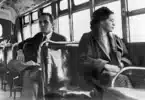The abolitionist movement was a social movement dedicated to ending the slave trade and freeing enslaved people. The most memorable figures come from the United Kingdom and the United States, but abolitionists were active in every nation that enslaved people. In this article, we’ll focus on the history of the abolitionist movements in the UK and US, as well as their main ideas and what abolitionism looks like today.
The transatlantic slave trade was legal for almost 400 years, but by the 18th century, the movement to abolish slavery grew in influence. In the UK, it took campaigners decades to finally abolish the slave trade and emancipate enslaved people, while in the United States, slavery ended with the Civil War and the Thirteenth Amendment.
The history of the abolitionist movement
The transatlantic slave trade existed for almost 400 years. While records are imperfect, the United Nations estimates that around 15 million people were victimized by this cruel institution. According to Slavery and Remembrance, Portugal and Spain began using enslaved people first to work sugar plantations, and eventually, crops like tobacco and rice. Other countries followed suit, and soon, the transatlantic slave trade was a huge enterprise. Not everyone supported slavery, however, and over time, the abolitionist movement grew in power and influence. Let’s talk about abolitionism in the two countries where it was most significant: the UK and the United States.
The abolitionist movement in the UK
According to information from the UK Parliament, the British got involved in the transatlantic slave trade in 1562. By the 1730s, the UK was the largest slave-trading nation in the world, but people were starting to express a desire to end slavery. In the 1780s, the abolitionist movement kicked off with a focus on London. The Society for Effecting the Abolition of the Slave Trade, which eventually became Anti-Slavery International, was founded in 1787. Thomas Clarkson, a campaigner against slavery, collected data on the brutality of slavery. Meanwhile, in Parliament, William Wilberforce brought bill after bill to end slavery, but none of them passed. In Haiti, where Spain had enslaved native people since 1492, freedom fighters fought back against Spanish, French and British forces. While the Haitian freedom leader, Toussaint Louverture, died in 1803, his lieutenants continued the war. In 1804, Haiti was established as an independent republic. It’s the only successful slave rebellion in history.
In Britain, the campaign against slavery continued into the early 19th century. In 1807, William Wilberforce made a twelfth attempt in Parliament, and this time, it passed. King George III signed the Act for the Abolition of the Slave Trade, which banned the trading of people in the British Empire. It didn’t free those already enslaved, however. Full emancipation was not achieved until 1838.
Racism and the slave trade are inseparable. Where does racism come from? Here are 10 root causes.
The abolitionist movement in the United States
The abolitionist movement in the United States used similar tactics as their counterparts in the UK, but progress looked different. The North was decidedly more opposed to slavery than the South, whose economy depended on enslaved people working in agriculture. According to History.com, anti-slavery sentiment increased after the Missouri Compromise of 1820, which made Missouri a slave state. The abolitionist movement spread to New York, Massachusetts and other Northern states. The movement grew more outraged when Congress passed the 1850 Fugitive Slave Act, which required the capture of escaped enslaved people, even if they’d made it to free states. The infamous 1857 Dred Scott decision, which denied Black people legal citizenship rights, also motivated abolitionists. Frederick Douglass, a formerly enslaved writer and speaker, was one of the best-known abolitionists. Harriet Tubman, who helped enslaved people escape to freedom, and William Lloyd Garrison, who published the anti-slavery paper “The Liberator,” were also influential.
While the UK ended slavery with the passage of a law, the United States went to war over the fate of the practice. In the late 1850s, tensions between the North and South were nearing a boiling point. There were a few reasons for the conflict, but they centered on slavery. The Southern states wanted the power to abolish federal laws they didn’t like, including laws that disrupted slavery. They also wanted to expand the practice of slavery into western territories. In 1860, Abraham Lincoln was elected president. The Southern states, who had opposed him, decided to secede from the United States. The Civil War began in 1861. Two years later, President Lincoln released the Emancipation Proclamation, which declared “all persons held as slaves” would be free. The Thirteenth Amendment, which was added to the Constitution in 1863, officially abolished slavery.
Slavery was abolished thanks to the persistent work of activists. Want to learn more about activism and how to get involved? Here’s our Activism 101 article.
The main ideas of the abolitionist movement
The abolitionist movements in the UK and the United States wanted the same thing: to end the slave trade and free enslaved people. While there were different ideas about how to accomplish these goals and what should happen after slavery ended, all abolitionists generally agreed slavery was wrong for humanitarian and religious reasons.
Slavery as a humanitarian issue
People who were pro-slavery often argued that enslaved people were treated well. Images of the kind-hearted plantation owner and happy slave were common, as was the belief that life would be much worse for Black people if slavery came to an end. Abolitionists spent a lot of time and effort educating people on the harsh reality. There was nothing kind or happy about slavery. In the late 18th century, abolitionists in England began collecting research on the slave trade, including how horrific the journey from Africa was. The ships were packed from stem to stern with people, many of whom were shackled. Ship captains cared little for sanitation and healthcare, while torture was a standard punishment for any type of resistance or complaint. Data estimates that around 2 million of those kidnapped for slavery died on the journey. Images of the ships, along with descriptions of the conditions on board, were an important tool for abolitionists.
Formerly enslaved people also played a key role in revealing the cruelty of slavery as they had personal experience. Many wrote what are known as “slave narratives,” which were pamphlets or books detailing a person’s life as a slave. Fredrick Douglass’ 1895 book, Narrative of the Life of Frederick Douglass, was one of the most popular. In this book, Douglass describes the horrific treatment he endured and witnessed while enslaved in Massachusetts, which included physical, emotional and psychological abuse. The authors of slave narratives often traveled and lectured around the United States and Europe, sharing the truth about slavery. The abolitionist movement’s goal was to provoke outrage and sympathy, so those who had once accepted slavery would feel compelled to fight against it for humanitarian reasons.
Slavery as a moral wrong
Educating people on the cruelty of slavery was a common tactic for both UK and US abolitionists, but many of them also argued against slavery for religious reasons. This placed them on the opposite side of Christians who used religion to argue for slavery. Pro-slavery Christians would point to Bible verses, claiming they shone a favorable light on slavery, while abolitionists argued that God made all people, including enslaved people, worthy of rights. While not all abolitionists were religious, there was a powerful religious thread through the movement in the UK and the United States. Some of the most prominent abolitionists, such as William Wilberforce in England and Sojourner Truth in the United States, frequently spoke of their religious faith and how it motivated them.
The Quakers had once been prominent slave traders, but they emerged as one of the first religious groups to argue against slavery. In 1688, four members sent a petition against slavery to their local meeting, but it wasn’t released until 1844. According to Stephen Angell, from the Earlham School of Religion, this petition could be the first direct protest against slavery. From the 17th century on, Quakers were the most vocal religious group to speak against slavery, arguing that slavery was a moral wrong incompatible with the Christian faith.
The abolitionist movement today
The abolitionist movement is still active today, albeit in a different form. With the transatlantic slave trade no longer operating, the trafficking of persons is a secretive, illegal practice. This makes it much harder to address. According to the International Labour Organization, there were almost 50 million trafficked people in 2021. That includes people in forced labor, forced marriages and forced commercial sexual exploitation. Activists raise awareness of the many forms of human trafficking, strengthen anti-trafficking laws, support survivors and more. In the United States, the abolitionist movement also works on ending legal exploitative labor, which affects people in prison. The Thirteenth Amendment may have abolished formal slavery, but it left an exception for slavery as a punishment for a crime. According to the ACLU, incarcerated workers earn an average of just 13-52 cents an hour nationwide, while in seven states, they’re not paid at all for most work assignments.
Interested in learning more about human trafficking? Here’s our article on Human Trafficking 101.
Many activists also push back against terms like “modern slavery.” There are many reasons why, including the differences in legality between the slavery of the past and human trafficking, as well as the causes of trafficking. By using the terms of the past in a modern context, activists also run the risk of whitewashing the abolitionist movement of the 18th and 19th centuries. Despite the importance of their work, abolitionists like William Wilberforce stopped short of accepting full equality between people of different races. They may have despised slavery, but many white abolitionists did not recognize their own racism. The fight against human trafficking requires different tools than the abolitionist movement of almost two centuries ago, so our language should reflect that.












